My diary
Day 46 - 13 Jun 14
We are apprehensive about travelling to Papua. It's been impossible to book flights in advance from Jayapura to Wamena. Trigana Air is the only company that flies to Wamena, and although there are tickets available for the flight to Wamena, the returns are fully booked and we want to ensure we can return to Sentani in time for the festival. We have emailed around the tour companies in Wamena and a man called Edison has responded and informed us we can purchase a flight for a fee on the black market. We are dubious but this seems to be the only option other than spending a week in Jayapura where there is little to do. When we reach Jayapura, we are able to purchase a flight to travel straight to Wamena. We meet two ladies from Belgium in the waiting area. They have a tour guide with them who has already arranged a Surat Jalan for them (a permit required
Baliem Valley - trekking in the mountains and meeting the Dani tribes
June 12, 2015
|
West Papua, Indonesia
Day 46 - 13 Jun 14
We are apprehensive about travelling to Papua. It's been impossible to book flights in advance from Jayapura to Wamena. Trigana Air is the only company that flies to Wamena, and although there are tickets available for the flight to Wamena, the returns are fully booked and we want to ensure we can return to Sentani in time for the festival. We have emailed around the tour companies in Wamena and a man called Edison has responded and informed us we can purchase a flight for a fee on the black market. We are dubious but this seems to be the only option other than spending a week in Jayapura where there is little to do. When we reach Jayapura, we are able to purchase a flight to travel straight to Wamena. We meet two ladies from Belgium in the waiting area. They have a tour guide with them who has already arranged a Surat Jalan for them (a permit required

to visit certain areas in Papua). Both the lonely planet and the employee at the ticket office have informed us that it's possible to organise this in Wamena, but their guide refutes this and suggests we will probably be sent back to Jayapura on arrival without it. We hope it is only scaremongering and as we have already purchased our tickets it seems to be the only option to get on the plane.
The airport on arrival in Wamena is tiny. There is just a metal gate out of the airfield and the airport building is like a barn - an open wooden structure with a corrugated metal roof and metal wire fencing. The luggage is unpacked on one side of a wooden fence and we wait like cattle in the other section, keeping an eye out for our bags for the porters to pass through the gaps. The Papuans are an entirely different race. They have Afro hair, darker skin, flat large upside down triangular noses and pair shaped faces. There is an old, seemingly senile man at the airport, who is wearing only a penis gourd to cover his privacy, trying to sell tribal souvenirs. A man approaches me and tells me his name is Wendy and asks if I am Amelia. I am slightly surprised, but it transpires he has been sent by Edison to collect us with regards to the plane ticket. Another Papuan, whose English is a little better, strikes up a conversation with us, so we take his number in case we want to use him as a guide. He tells Hannah that he grew up with missionaries, so we would be interested to hear his life story. Edison appears outside the airport but promises to
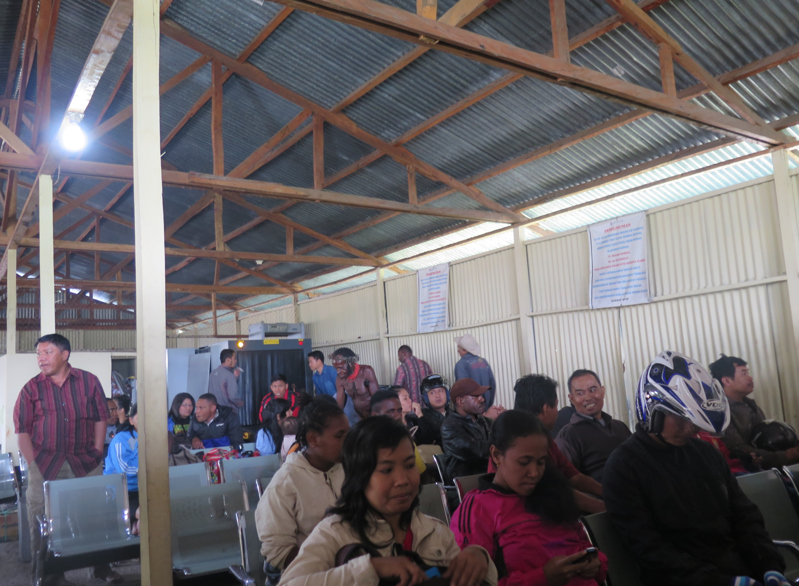
bring the plane ticket on a different day as he has to visit a family member in hospital. I am slightly cynical as we've heard this excuse before. Edison insists that it is no longer necessary to have a Surat Jalan as the rules changed a couple of months ago. He recommends Wendy as a guide, before departing.
We're uncertain about Wendy - his English is ok, but not as good as the other guide's and he's friendly but we haven't warmed to him completely. We are perhaps unfairly judging him based on his scruffy looks and bright red, broken teeth, which makes his smile unattractive. He shows us to a hotel that has been suggested to us. It's located on the road that runs parallel to the runway, aeroplanes landing and taking off over the green mountains in and out of the valley. There are no roads to Baliem Valley so everything must by imported and exported through the air. We find out later that a road from Jayapura was started to be lain 10 years ago, but there was a landslide and the whole project was abruptly halted, with no plans to continue since. The hotel is dirty and there is no shower in our room, but it's the cheapest accommodation we're likely to find. The manager at the hotel tells us we actually do need a Surat Jalan and Wendy says he will help us. We leave our bags in the hostel and follow Wendy through the town. The sky shines blue and the temperature is pleasant. A scruffily attired, bare-footed, bearded man is following us at a close distance - he is Wendy's friend.
The town is populated with Papuans, some of whom are also bare-footed and dirty, as well as an obviously different race - people who look like they originate from Java. The town is shabby, walls tagged with uncreative graffiti, although the roads and pavements are good. The buildings are simple rectangular structures covered in corrugated metal roofs. Above the shop fronts are decorative facades, similar repetitive patterns over each building: a thin column followed by 2 steps up to a curved top beneath which are square-shaped cut outs and 2 steps down back to a thin column. They are brightly painted with a different coloured border, such as a bright green next to yellow. The simple pattern has a slight Art Deco feel.
We stop in a small shop where a plastic stool and photo-shoot umbrella has been set up against a red background, to get photos taken. In the pictures, there's more body than head and they certainly wouldn't pass as passport photos in the UK but they're sufficient for our purpose. At the police station, a policeman puts together our Surat Jalan and tries to charge us, which we understand from the lonely planet is not necessary, so we refuse payment. He laughs and accepts this. We get photocopies taken of the permits before going to lunch and discussing a possible tour with Wendy.
Wendy's been incredibly helpful so far, but we want to make sure he can offer a good price and that we like him enough to use him as our guide for a 4 day period. We discuss a potential itinerary. The tours in Papua to visit the Dani people are ridiculously expensive, which I have already mentally prepared myself for. Wendy eventually agrees to bring down his original price for the trekking from 7 million IDR to 4 million IDR if we are happy to use public bemos in replacement of a private car. In addition to this, the cost to pay a village to put on a traditional dance is 1.5 million and the cost of a pig could be anything from 1 million upwards if we want our experience to include a traditional pig feast. The pig is clearly their most prized possession - a whole cow bizarrely costing much less.
In the afternoon Hannah speaks to the guide we met at the airport, to see if it's possible to get a better deal, while I walk to the 6 hotels in town to try and locate other tourists. We figure that we could save a lot of money if we can find others to share the cost of the pig and warrior dance. My searching is futile. In every hotel I ask if tourists are staying there. After at first misunderstanding the question as they expect me to be inquiring about a room, the answer is a resounding 'no' with 2 exceptions. At hotel Minak, the 2 Belgium women are staying, but they are not around and we know they have already paid for a tour guide and will be in the valley for 2 days only.
At Hotel Pilarmo, confusion ensues as the staff assume I know someone staying in the hotel. They ring up to the room of two American tourists to inform them that their friend is waiting in the hotel lobby. One of them comes downstairs. He and his friend saw the traditional warrior dance the previous day, but they chose not to partake in the pig feast and he suggests this is a good option to save money, as he is not convinced that seeing a whole pig being slaughtered will add much to the experience. They will be trekking in the south tomorrow, which is the same direction we are going. However, he makes it clear, in a roundabout way, that the two of them wish to travel alone, as they are both professional photographers, so do not want to share their experiences with other tourists, who will be taking amateur pictures and will potentially get in the way. They have been travelling together since 1992 and have been to 98 countries, soon to tick off their 100th. After Baliem Valley, they are heading to Korowai to see the tribes that live in tree houses. I am jealous as it sounds like a once in a lifetime experience but will cost $2000. They must be very successful photographers to fund this expensive, nomadic lifestyle.
In the hotel I meet another older American sitting in the garden. He says he would love to go on a tour, but actually he is in Papua on business. He has lived in Jogjakarta for 2 years and is working on healthcare improvement, currently reviewing and researching the conditions in this area. He has a team of Javanese working with him, but he mentions how difficult it is for them to work in Papua, due to the natural contempt, bordering on hatred, generated by the Papuans towards them. He says it is dangerous for them to be working in the area; they must tread very cautiously so as not to offend.
I have heard a little about civil unrest and the independence movement, but have not yet read up on the current situation to understand enough. Interestingly, every shop, hotel, restaurant are visibly run by staff from Java or other areas of Indonesia, which I imagine must cause tension between the two distinct races, but I have also noted friendships existing between the groups, perhaps within the younger generations. He says, as an after thought, that there are no issues in terms of safety for white-skinned people - perhaps to allay any potential fears he may have arisen in me.
After much negotiating, Jon the other guide, has not quite agreed to match Wendy's price, so we choose Wendy based purely on the monetary factor. We call him to let him know, as he will have some organising to do.
Once the sun has gone down after 6pm, there are no street lights outside our hostel, so we are slightly apprehensive about walking the short stroll into town on our own. We are not yet familiar with the surroundings, and I have been made uneasy after being followed by a guy on a scooter while moving from hotel to hotel as he waited outside, although the likelihood is that he was perfectly harmless and was just hoping to make some money by giving me a ride. We ask at reception where the nearest Internet cafe is and the man behind the desks asks an older Papuan guy to escort us. There are lots of guides that hang out on the leather sofas in the hotel lobby, either sleeping or chatting or watching telly. They must all be hoping for tourists to miraculously appear, rather than tracking them down as they arrive in the airport. The old guy seems nice but he isn't particularly charismatic and his English is lacking, but after speaking to him for a while we gather that he probably knows the valley and the tribes far better than the younger guides. A man pulls up alongside us as we walk the pavement - he has just brought a brand new car and he is taking it for a spin (or rather, learning to drive) with his whole family crammed in the back, a couple in the passenger seat. He tells us that this man was his teacher when he was a guide and obviously holds him in high esteem. It seems sad that the older, more knowledgeable guides seem to have been pushed out by the younger generation who have a better grasp of English. We buy him dinner at a Warung and he kindly walks us back to the hotel.
Day 47 - 14 Jun 14 Kelise
In the morning, Wendy is an hour late, which is not a promising start.
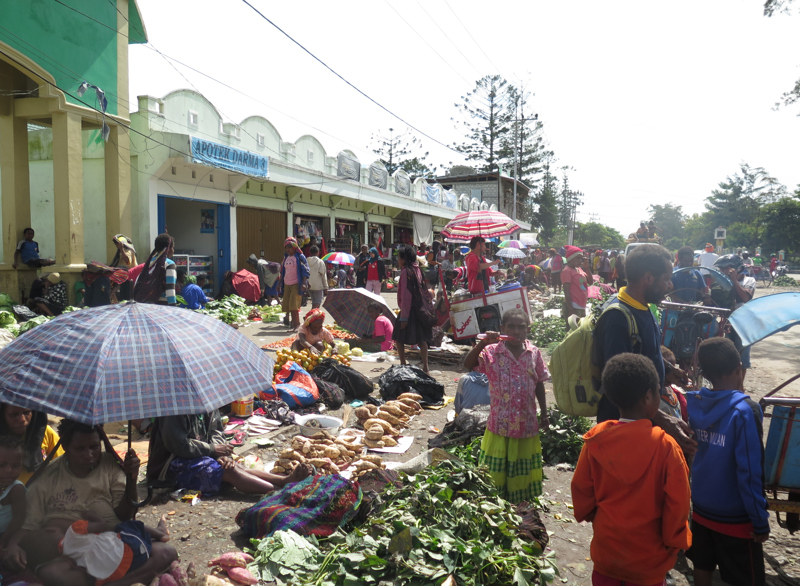
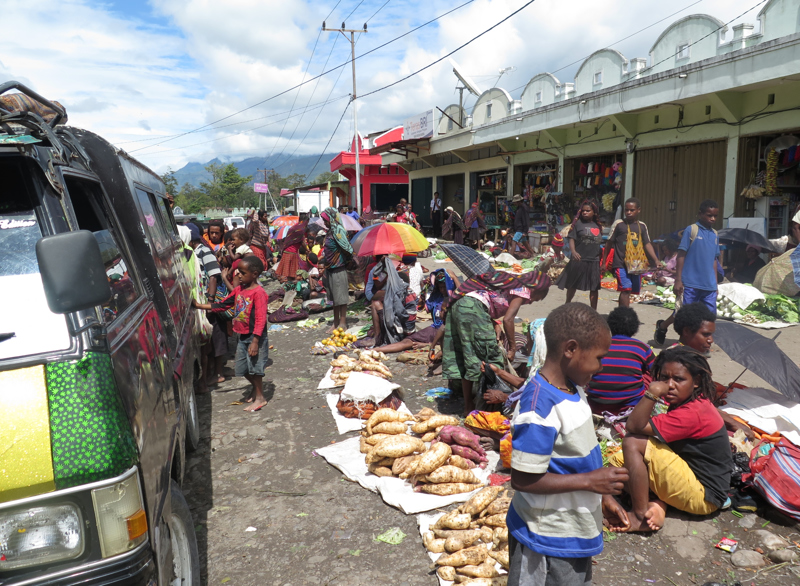
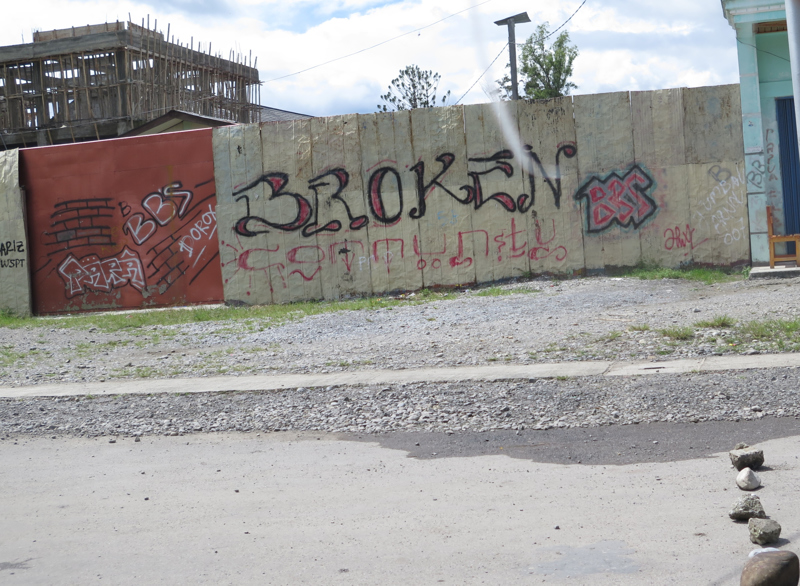
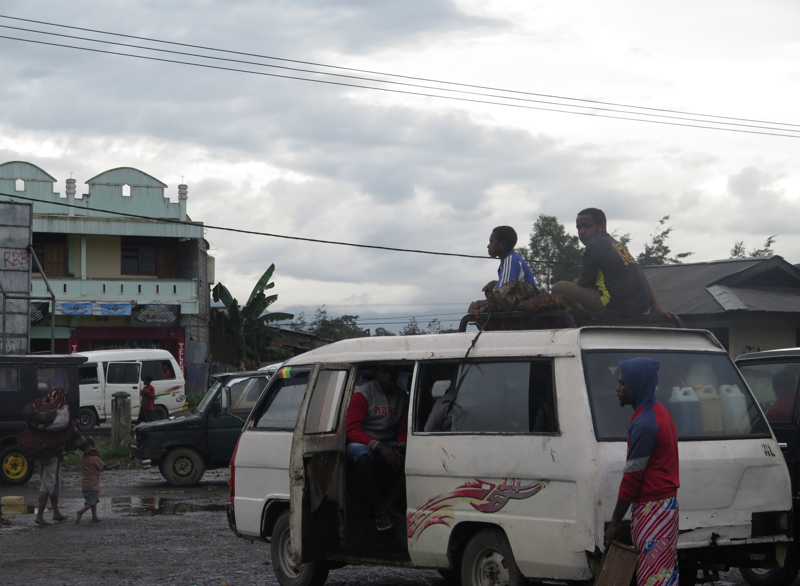
We wait in the hotel lobby eating the doughnut and cold sweet potato snack provided. When he eventually turns up, he is in a jubilant mood - it seems like maybe he was out celebrating his good fortune on procuring this job last night, with the deposit money we had provided, and we hope he's not still drunk. We take a tuk tuk to the market to buy food for the trek. He passes us a fresh passion fruit to break and suck out the juicy, sweet seeds. They're delicious. The produce in the market looks incredibly fresh and there is a huge variety of colourful, shiny vegetables and fruit, UK supermarket worthy from an aesthetic perspective.
Wendy hires a truck to transport us along the road to Sogogmor. There has been a landslide a few years back and the road has not been repaired since - makeshift wooden planks have been joined together for bridges over gushing streams of water. The road comes to an abrupt end over where the river rushes down the valley. Wendy stops us from removing our shoes to wade across and carries us one by one on his back through the surging water at his feet. It must look pretty funny - perhaps he is doing it to show off his manliness to the locals. We travel the remaining road by foot, stopping at the military check point and police station to provide them with copies of the Surat Jalan. It seems a bit excessive to have an army base here in the middle of these peaceful mountains.
The road ends to be replaced by a path climbing up the mountainside. Wendy sits down with our porters before setting off. He takes out a bag of beetle nuts and starts chewing on one manically. He also opens a little black package, made from a torn piece of bin bag, full of a white powder that looks like coke (we hope it isn't a drug), which he dips the stem of the nut into to eat. He spits out the red liquid, which squirts in a precise direction onto the ground. The beetle nut looks like mashed up bloody gums in his mouth, as if he has just been punched in the teeth. It's such an unattractive habit, but all the Papuans appear to be addicted to it. We saw the same in the traditional villages in Flores. The streets in both places are covered in patches from the constant spitting, as if blood is splattered on the ground. We turn down his offer to try it. He tries to explain the taste - he says it is hot and fiery and burns your mouth.
We start up the slope, passing a group of barefooted women, weaving as they walk, lugging groceries in handmade woven bags hanging from their heads. Their t-shirts and skirts are modern but dirty - one branded Adidas, another says 'sexy style', their hair short and braided, colourful strings of tiny beads wrapped several times around their necks, in red, blue or yellow. They are clearly from the village. One of the women stops me and I misunderstand her request thinking she wants her photo taken to see the picture. She then demands money for the photo - I'm slightly taken aback but soon
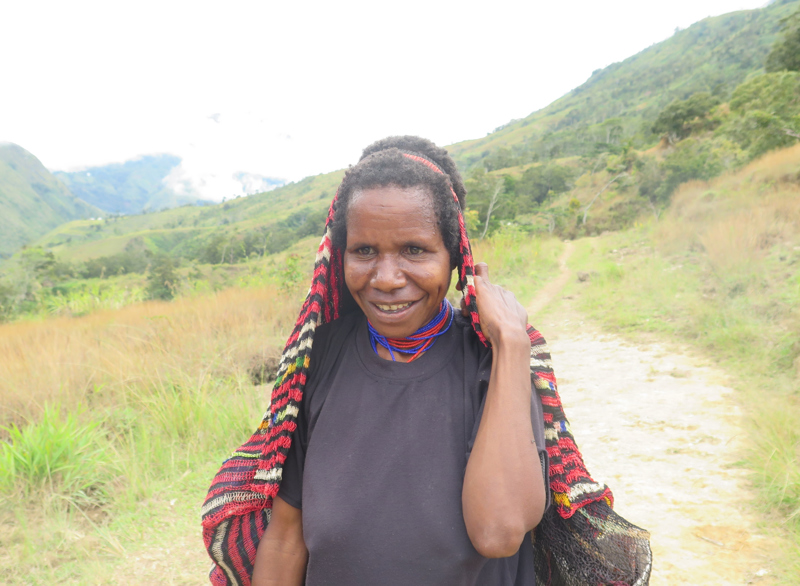
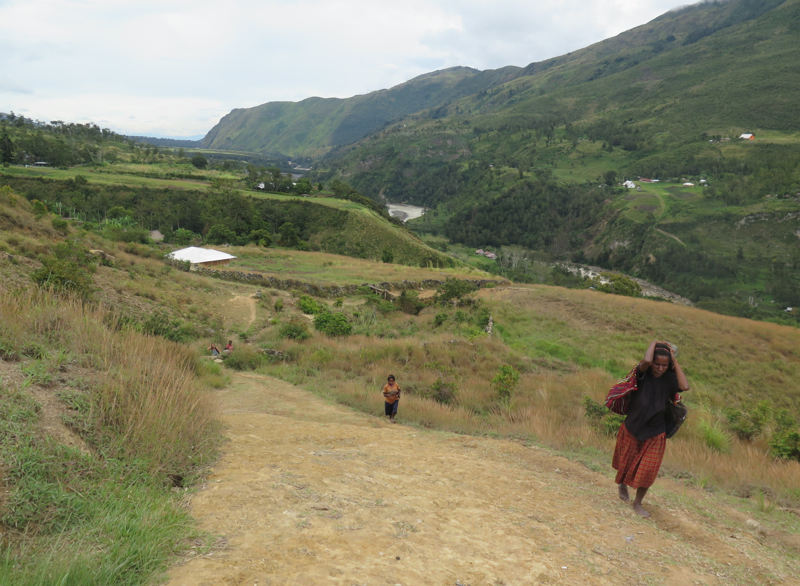

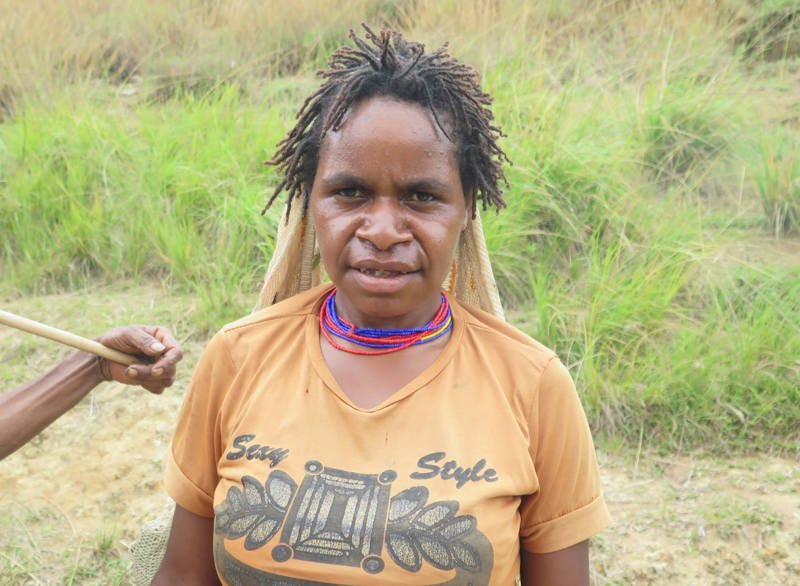
realise this is what the villagers now expect having discovered it's an easy way to make money from tourists. Wendy has bought us packets of cigarettes to hand out, so I give them one each instead.
Further along the path, we are accosted by a small old man wearing his penis gourd, his shoulders and upper torso blackened with a form of paint. He is carrying an umbrella and a woven bag is slung over his shoulder. He's hoping for money for a photo, so we comply and get a picture of the 3 of us. Hannah and I tower above him, while he puffs away enthusiastically on the cigarette we've given him. The valley itself is beautiful, the river snaking back behind us, cutting through the green mountains. It reminds me a little of the Lake District with its long grasses, wooded areas and stone walls, the path crossing little streams tumbling down it's steep sides. The ground is clearly very fertile - disordered fields line the sides of the valley and kitchen gardens sit outside the traditional huts that we pass. Sweet potatoes
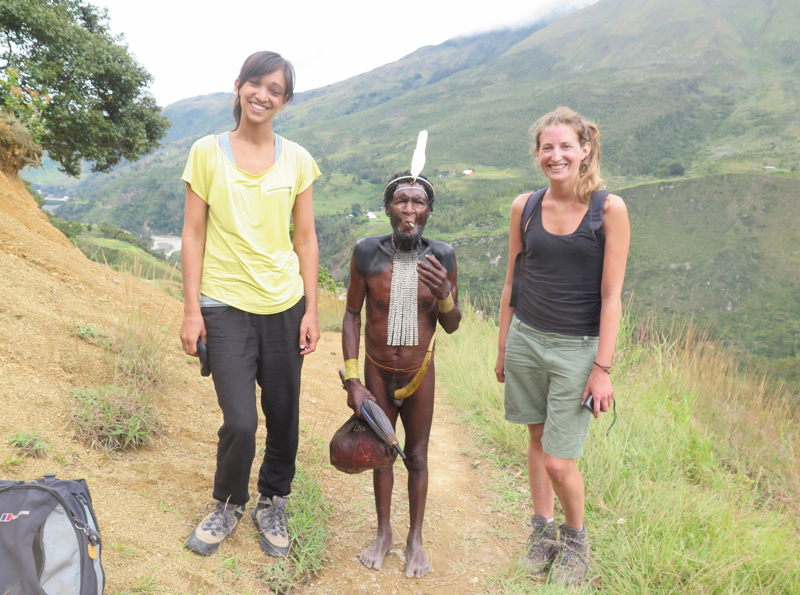
grow in abundance, the staple diet of the Papuans, along with corn and cabbages. We pass a fat, grey pig and its piglets trundling through the undergrowth. Some of the way is quite steep as we make our way up the side of the valley.
We have been told it will be a 5 hr trek and Hannah is taking it slow to conserve energy to what she expects will be a gruelling trek ahead. Instead, we arrive in Kelise village just after midday and have the whole afternoon to sit around and relax. The women and a few children are sitting on rocks chatting. They nod as we enter, but although not unwelcoming, are generally disinterested by our presence. We are staying in a guesthouse, a traditional, circular, wooden building, with a low, cone-shaped, thatched roof. It's clean inside and bare, with the exception of the 2 thin mattresses and blankets provided, but it's spacious. A pretty, concentric pattern is
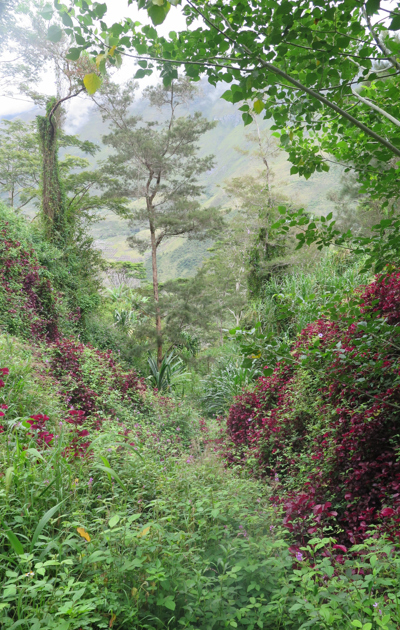

created above our heads, where the thin branches point upwards towards the ceiling's centre. There is a ceramic squat toilet in a shed, which is balanced slightly precariously on wooden planks with a long drop below. Where a stream runs out of the hillside, onto slabs of rock and back into the ground, a pipe has been connected to create a free flow of water used for washing, stone walls built surrounding it with a small wooden door for privacy.
The porter has already made a fire on the hearth, centred in a rectangular hut, which is used as the kitchen. Dried grasses carpet the ground for sitting. Our guide neatly cuts up vegetables into small pieces, declining our offer of help. He meticulously fries first the onions and garlic followed by the mixture of potato, carrots, beans and cabbage. After pouring away the oil, he adds water, a sachet of flavouring and copious amounts of MSG. Once boiled, he cracks in an egg and noodles. It tastes delicious despite the saltiness, in
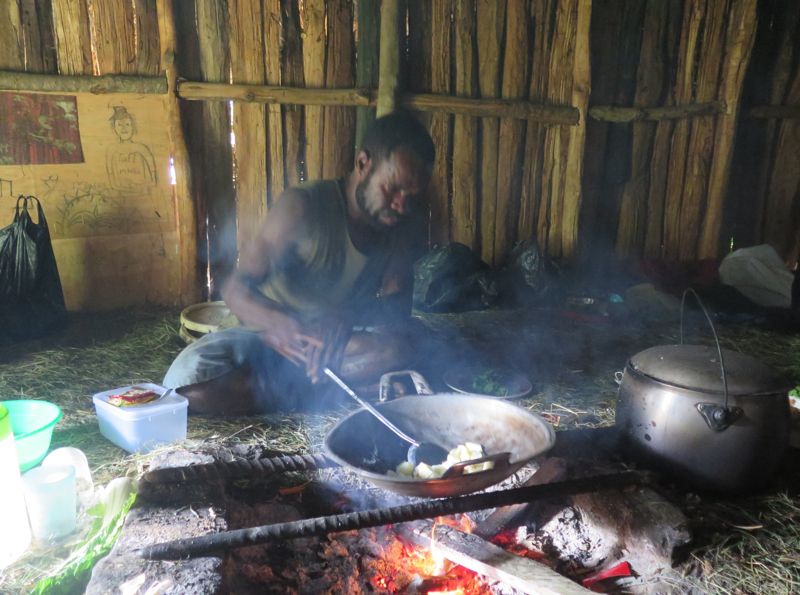
comparison to the simpler meals we had expected. After lunch, the porters and Hannah doze in the hut, whilst I read amidst the lingering wood smoke in the gloomy half light.
In the afternoon we visit a few huts in the village to see how the people live. We pass a group of kids returning from school. They copy the silly walk that I clownishly put on up the path, laughing at me. As our paths diverge, they shout 'gula gula' to our backs, which I only afterwards realise means sweets.
The men sleep together in one hut and one woman, with her children, will inhabit her own hut. This living arrangement is strange to us, but seems to fit the apparent culture of polygamy. Since our guide has two wives, we assume this to be the cultural norm, unaffected by widespread Christianity, which all villages appear to now practice and which replaced animism after the invasion of the missionaries 50

odd years ago. Unlike our hut, although the same size, there are two levels: the below with a central fireplace, the sleeping area above, with a whole cut out in one corner to enter the upper level. They're not tall enough to stand in and I struggle ungraciously to enter the hut through the tiny doorway. There is no concept of a chimney and the hard wood inside the hut, blackened from the wood smoke, shines like ebony in the flash light of our cameras. Apparently a hut will normally last for 20 years, after which a new one must be built, which will take approximately a week. I am surprised they don't go up inflames more often.
We join the chief and his family in their kitchen, where they are baking sweet potatoes using a makeshift oven made from stones previously heated in the fire, covered by grasses to keep the heat in. The potato leaves are also eaten, cooked with spices. The chief is wearing only his penis gourd. His face is heavily lined with wrinkles,
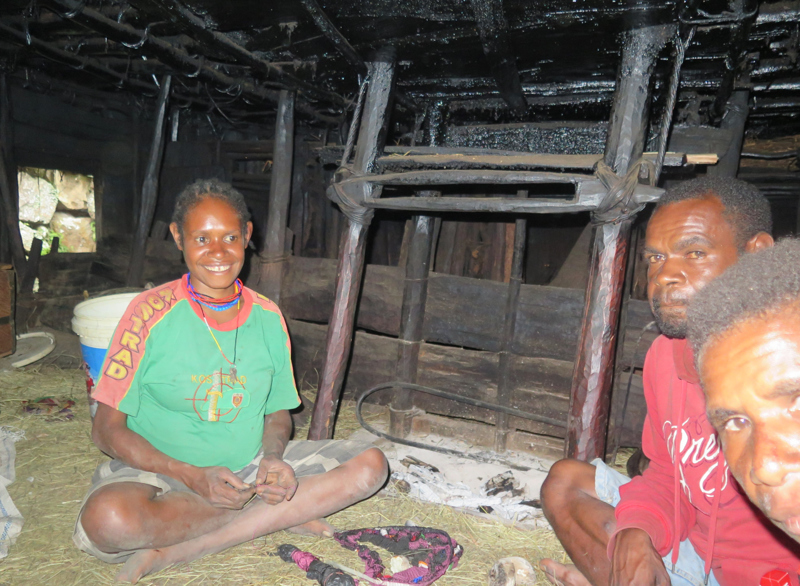
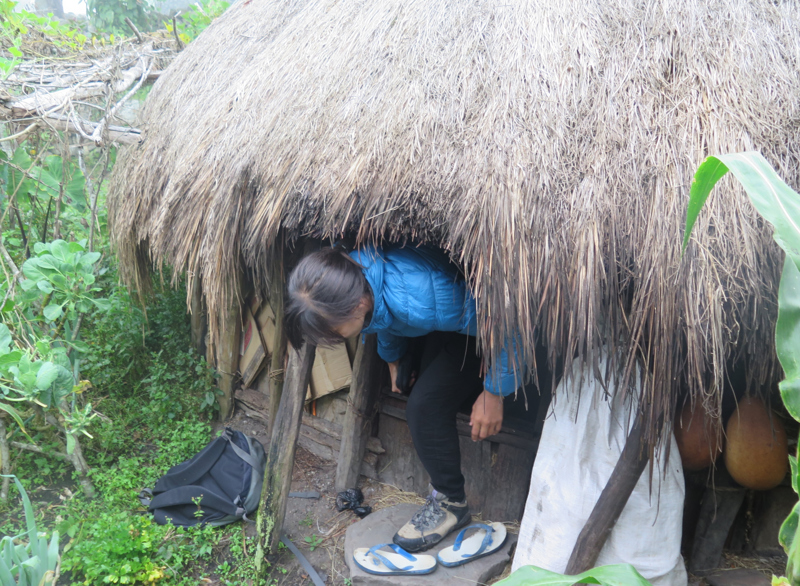
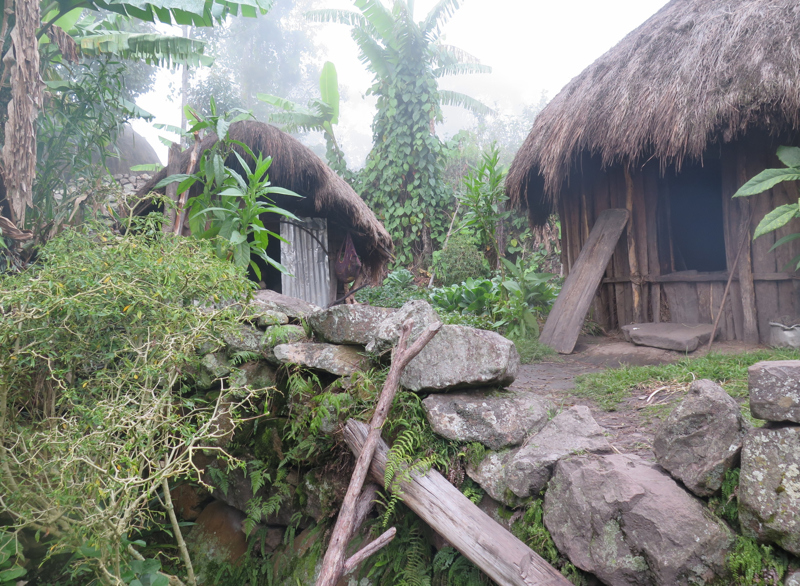
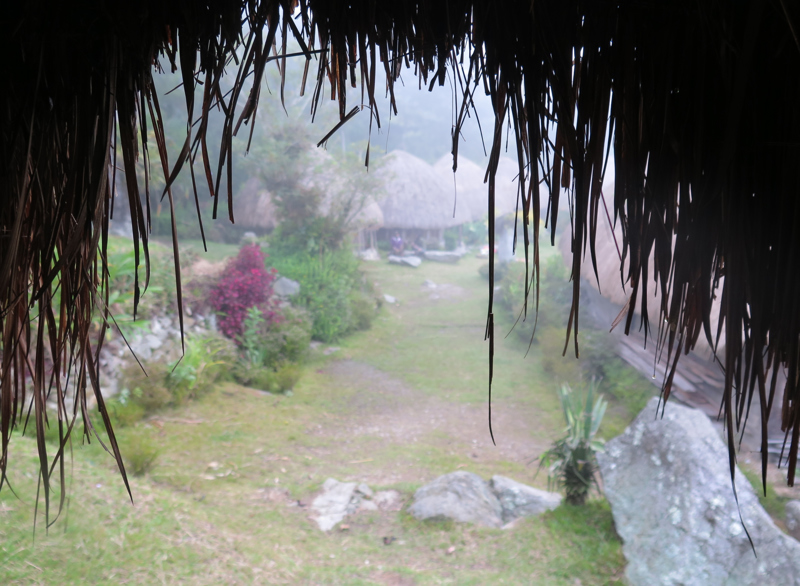
but his shoulders look broad and strong. His countenance is trustworthy, and he eschews an air of calm mixed with a look of strength of mind. He is smiling and welcoming. We don't know how much control the traditional chief really holds over decision making now though. We share around sweets with the children and cigarettes with the adults and due to the language barrier, instead we simply smile until our jaws ache.
Our meal in the evening is just as carefully prepared. We eat rice and vegetables, with fresh chicken boiled and then deep fat fried until the skin is crispy and delicious. At night my sleep is disturbed by the disorientation of my surroundings. I dream of dogs, turned-wolves attacking me and past relationships resurfacing.
Day 48 - 15 Jun 14 Ugem
In the morning Hannah notices a beautiful spider’s web freshly woven across the bathroom door, tiny droplets of silver dew clinging to its thread visible in the sunlight. We carefully duck underneath so as not to disturb it. The villagers lay out their souvenirs hoping we will purchase something. I buy a small bag with feathers as a present for my sister. The chief poses with us and another man appears out of the wood work, with his full length spear a pig bone placed through the hole in his nose. The two Americans are there and we leave them
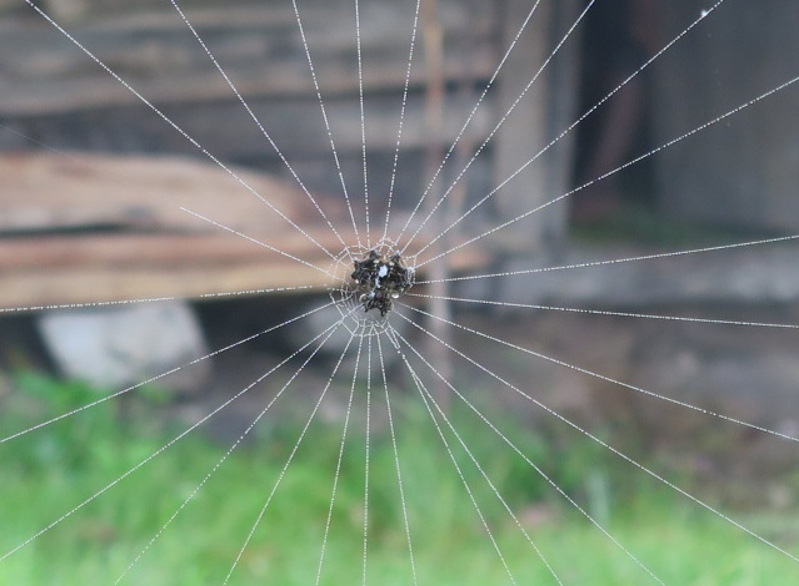


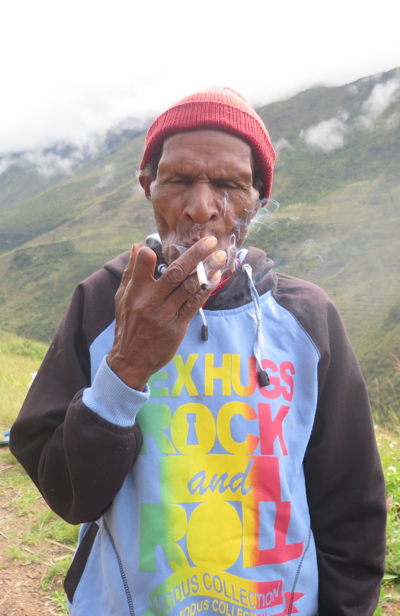
taking photographs. We are told today's trek will be more strenuous. We head down slippery, muddy paths to meet the rushing white water in the crease of the valley's bottom. We pass a man wearing a colourful jumper with the printed words 'sex hugs rock and roll' and a red beanie. He looks pretty cool, so we ask for a photo, handing him cigarettes in exchange. He smokes with his two middle fingers, as his index finger has been previously removed. It was a practice, which we presume is no longer in effect, that when a close relative dies, a finger is amputated to symbolise their loss. It seems an extreme measure to ensure a constant memory of the close life lost. The apparatus used to remove a finger is a blunt object, which the villagers now try to sell as souvenirs.
We reach the bottom of the valley, where a wooden planked suspension bridge crosses the river, supported by metal cords, so it is sturdy and we walk the 50 metres across feeling no trepidation. From there the path leads continually upwards. We pass a small village where we buy bunches of bananas from a lady sitting on a stone wall. They are slightly larger and yellower than those we have seen in Indonesia so far. We sit to eat them, watching a group of kids playing a game in which there appears to be no rules, involving hitting a plug shaped object with sticks, into the air. They giggle when they look at us.
The path steepens up the grassy
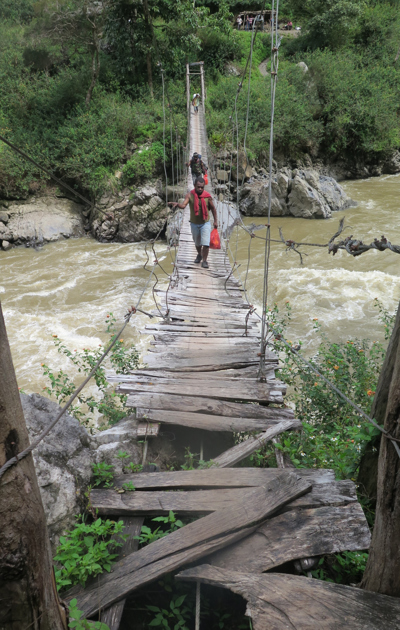

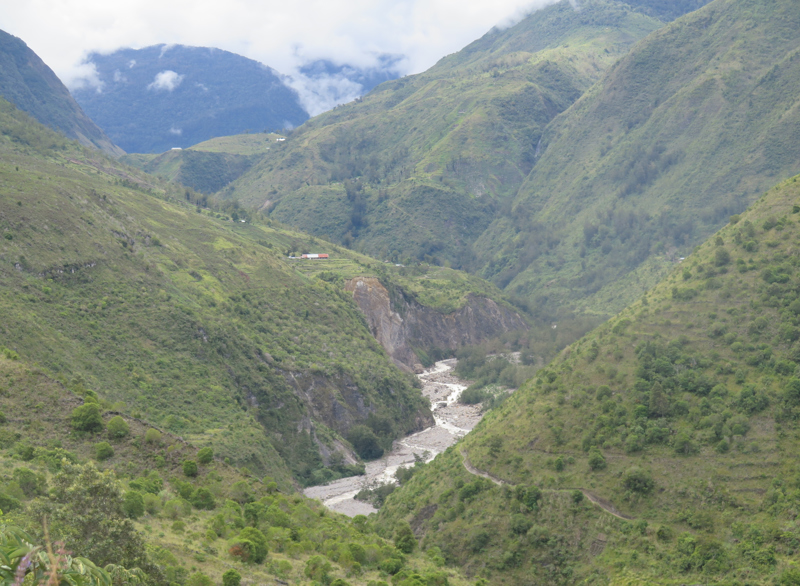


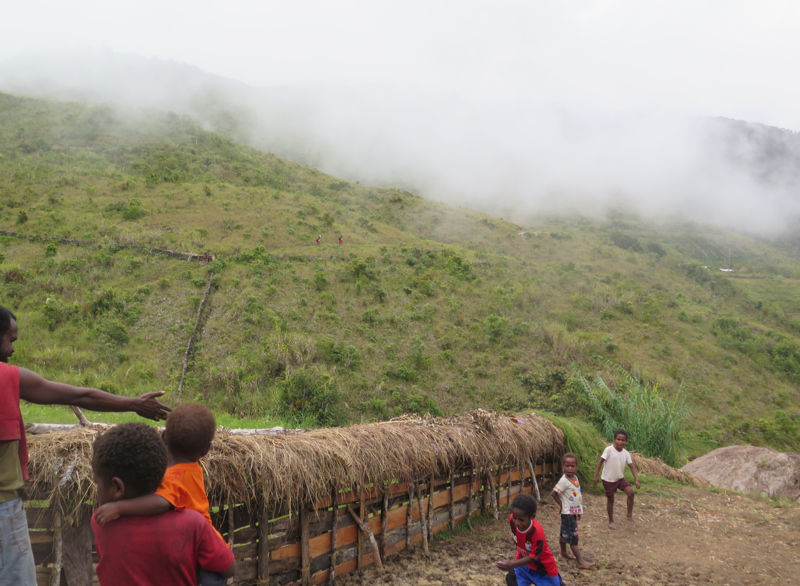
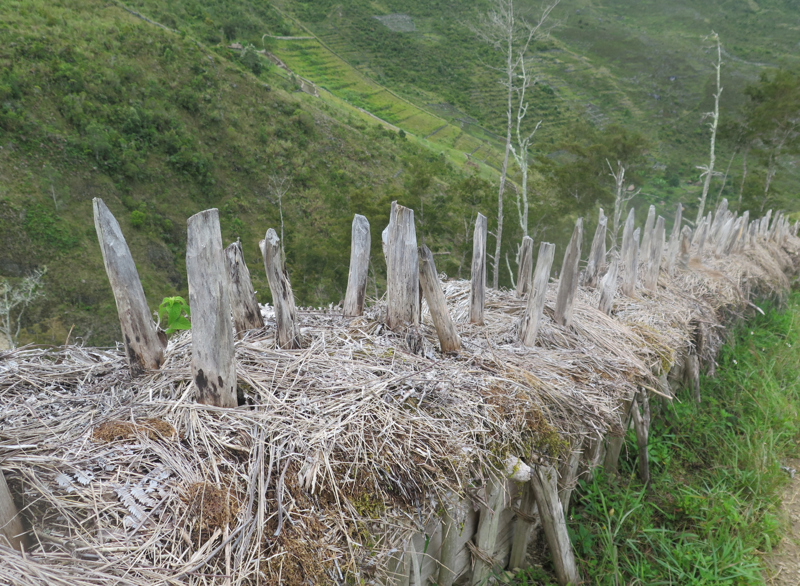
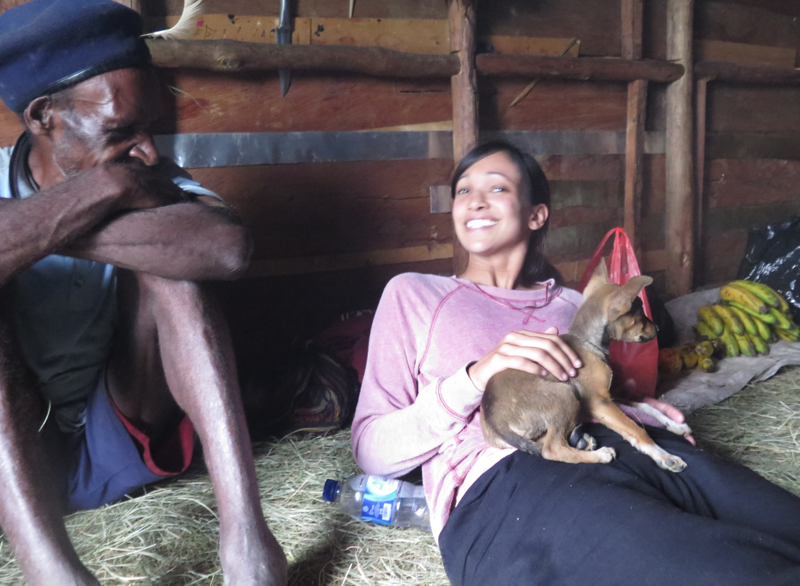
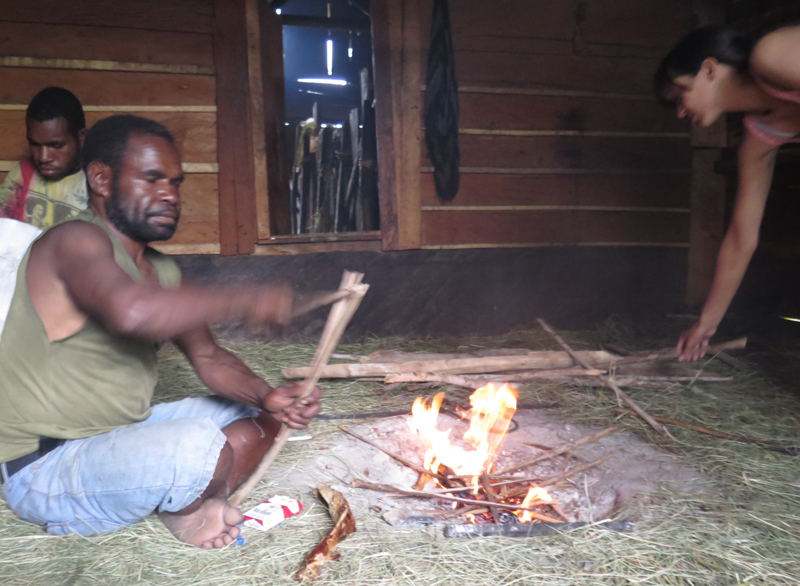
mountainside, requiring breaks to catch our breath. As we stop, looking backwards below us, the view is breathtaking. The silver snake of the river in the sunshine glides through the sandy banks far below. Upon reaching the top, we have an almost birds eye view of the opposite mountainside, where a grid of small, disused fields sit, broken up by stone walls in a random pattern, creating organic shapes. It's a Sunday and we pass children playing together outside a church, built from plastic, corrugated sheets. A man is playing his guitar in the sunshine. This area is called Ugem and we stay in one of the houses here, this time with the fields for a toilet. We spend a similar afternoon relaxing in the kitchen area with some of the family and their cute puppy, the guide and porters and going on a stroll to visit the village. Wendy points out the hanging plant used to make the penis gourd. The afternoon has brought with it a heavy mist, so the surrounding views are hidden. From early evening and throughout the night the rain is torrential. My dreams are again
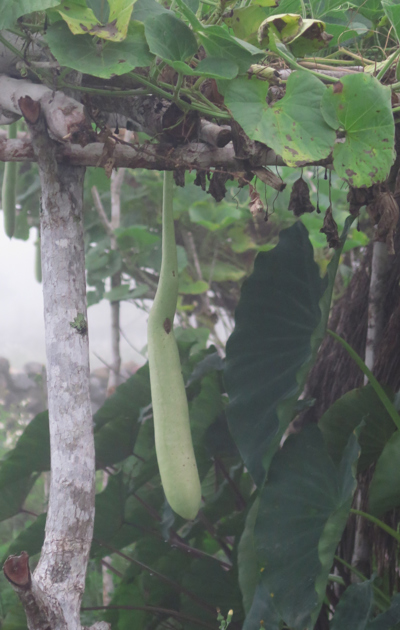
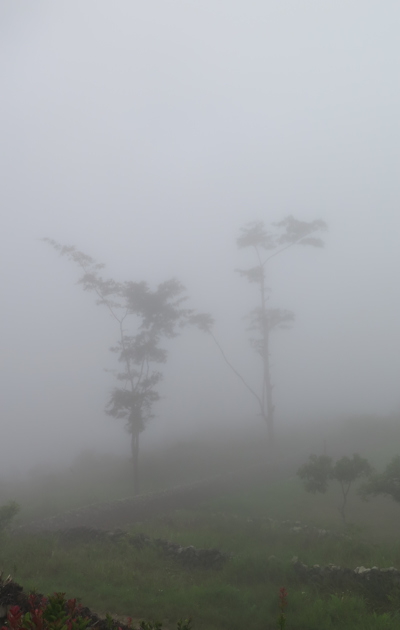
disjointed and vivid. I remove jewellery from my bag which belongs to my friend Isobel. The emerald encrusted fish jerks to life, as the other pieces of jewellery metamorphose into fish surrounding me. We are in a national park and I run around trying to locate someone in charge, as I worry these fish, growing rapidly in size, may harm the ecosystem in the area.
Day 49 - 16 Jun 14 Ugem to Wamena - Obia
We set out in the morning dew. The rain has cleared and ethereal clouds softly coat the sky ahead. A simple wooden cross stands at the top of the grassy slope. Wendy worries the planned route back will be too slippery and landslides may have occurred, so we take the shorter route back to Sogogmore. We slip and slide down the muddy path with the porter and guide's assistance, down to the path running along the bottom of the valley on the opposite side from which we
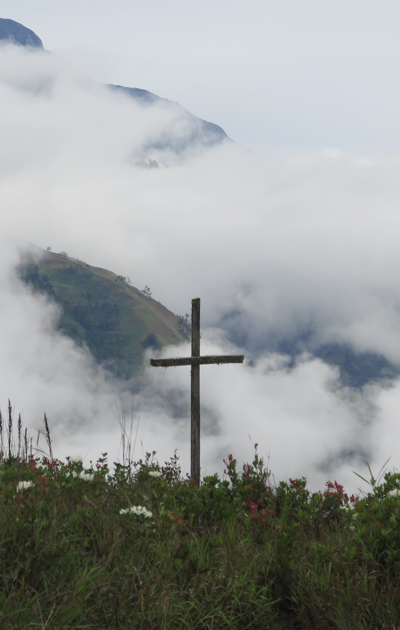
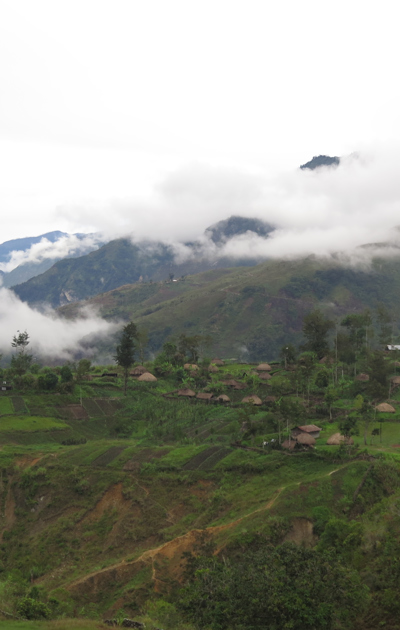
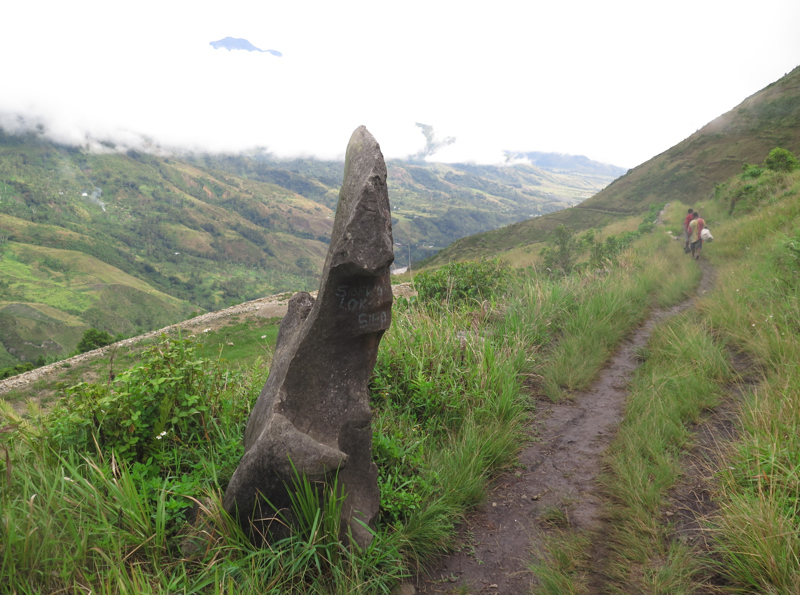
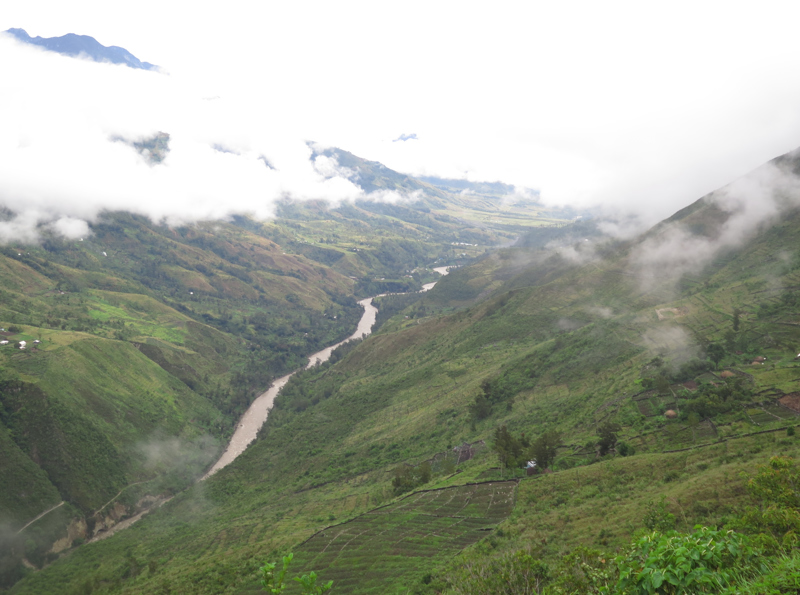
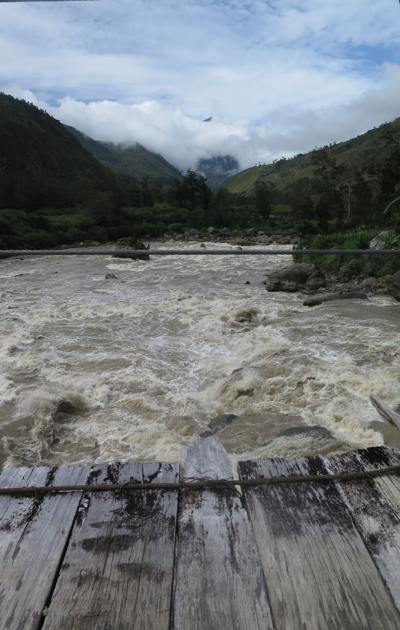
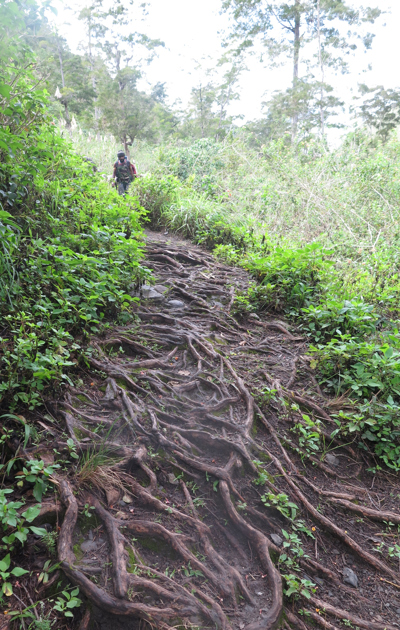
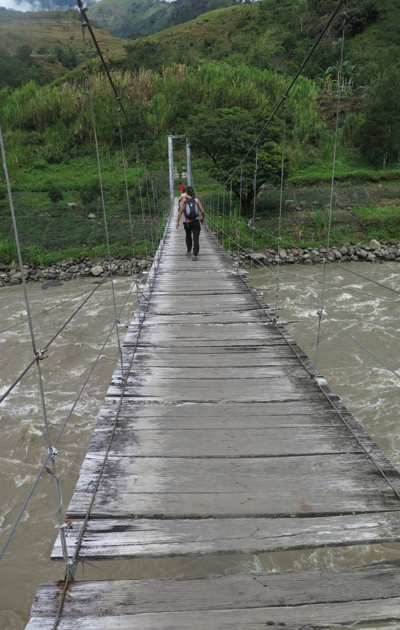
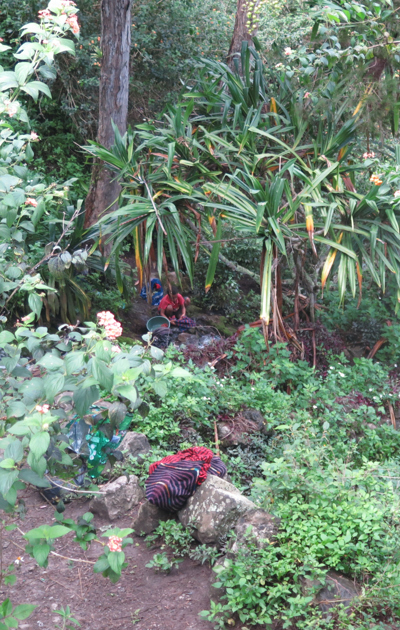
came. It's a pretty walk and is just over an hour before we rejoin the start from the first day.
We remove our shoes and wade across the ford in the river. A couple of guys are trying to manoeuvre their scooters across the rapid water under foot. One of them gets stuck and a few people come to his aid. Further along the road we wait for the Bemo to fill before heading back to Wamena. It is a shell of a vehicle, that you'd expect to see in a scrap yard, and we're amazed they've managed to keep it alive and running.
Back in town, we leave the bulk of our stuff in the hotel as the porters won't be joining us on the final day. We eat lunch and then search the hotels for tourists in case they want to join us for tomorrow's festivities, but with no luck. We go first to the market, where Wendy
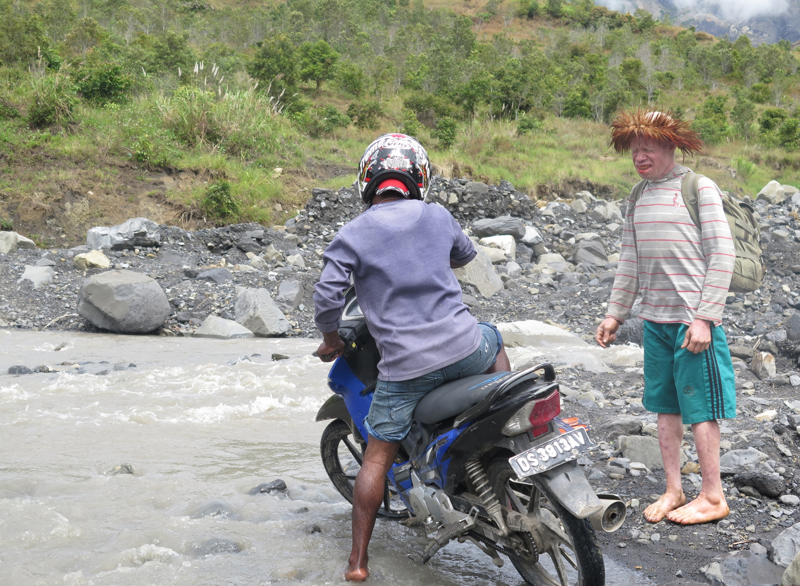
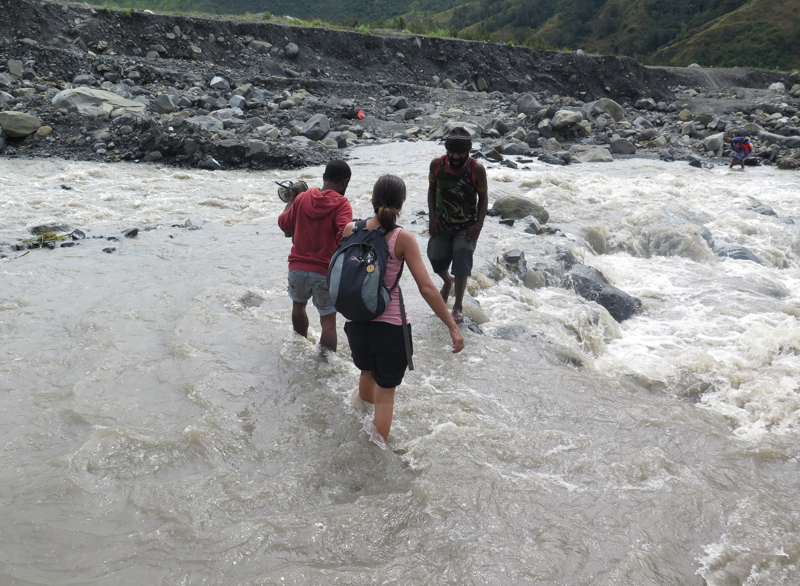
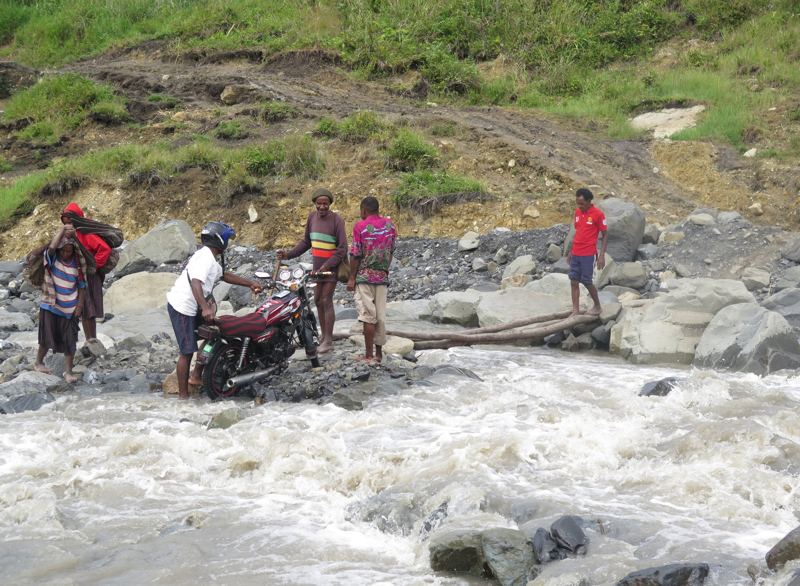
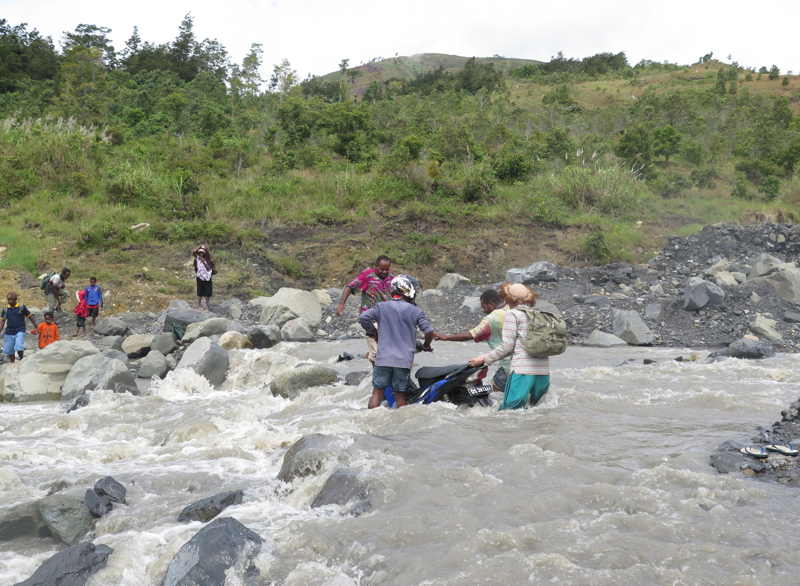
heads off to bargain for a live pig. When he returns, the best price we can get is 1.5 million. I am not particularly keen to spend such a large amount on seeing an animal sacrificed, but in a superficial context, since the pig feast will be put on just for our benefit. Hannah agrees, although I hope her decision is not based on her awareness of my budget. We head to the area in the market where the pigs are sold anyway, so Wendy can save face after trying to bargain. The lowest price now offered is 1.1 mio, but having seen the size of the pig, which is still so young and has so much potential life to be reared and eventually fed to a much larger group of people, we are now even less keen. The surround sound effect of traumatic squealing lessens the appeal of killing a pig further. We leave the market to head to Obia, a village in the north.
In our hut at dinner, we're joined by the man who looks after the finances for the village. We ask Wendy how the money from the tourists for the traditional dances is spent, since it seems a substantial amount. Apparently he keeps a log of everyone that has passed through in the book and the money is kept in a bank account. From what we understand, it is used for communal village expenses such as the purchase a large pig for the Christmas feast or for the health care of a sick villager. We also meet the chief and inquire about his role in the village. Wendy tells us he is a farmer and he has little say in the way the village is run. Instead, a leader, appointed

and paid by the government, is in charge of the village.
In the hut is another girl, dressed in modern clothing, with gold hoop earrings. It transpires that she is Wendy's girlfriend. They have been dating for 3 months. We're confused as Wendy already has 2 wives (one who lives in Sentani, the other in Wamena) and he has fathered 3 children with each. He tells us now that he also has 2 girlfriends! We wonder how he manages so many relationships. He interprets our question literally, telling us that it is easy now since he has a mobile phone. We retreat to bed in our hut early to give them some privacy.
Day 50 - 17 Jun 14 traditional dance
After breakfast, we wait for the villagers to prepare for the traditional warrior dance. As their normal attire is now clothing, they dress up in
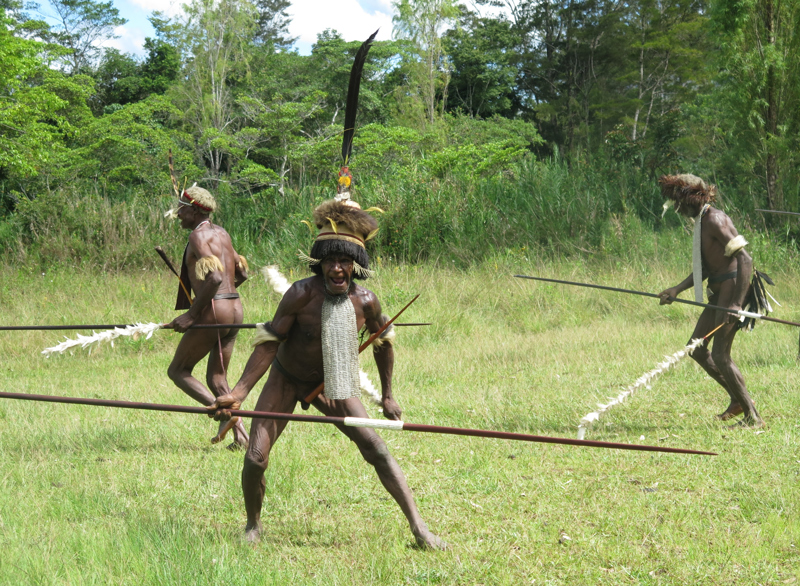
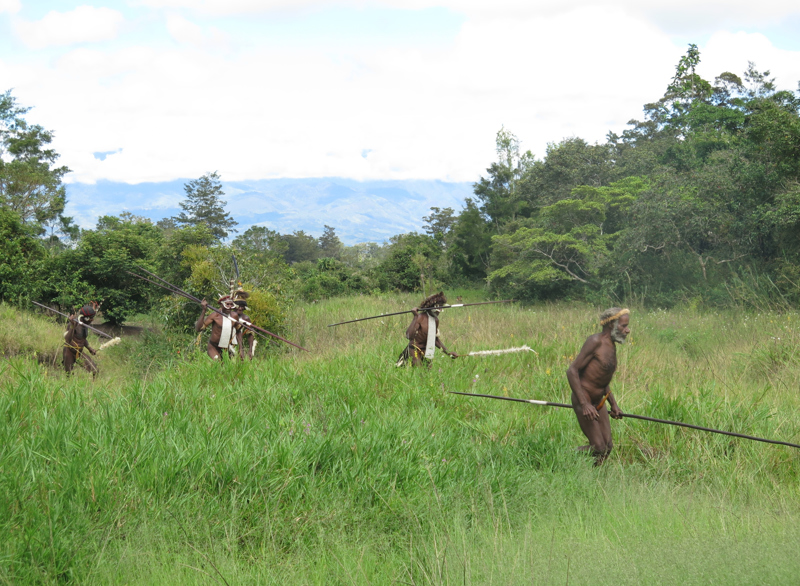

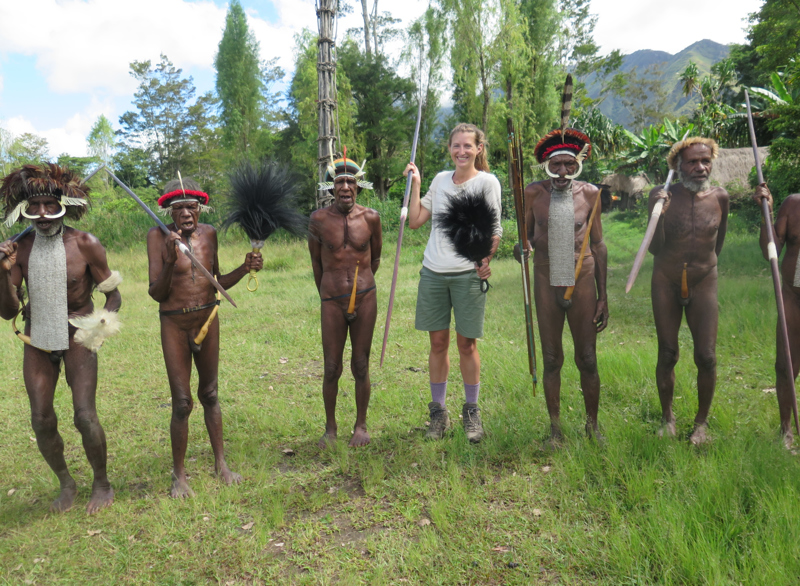
the old traditional wear for our benefit. The sky is blue and we're led out onto the green plane, where a tall tower is built from 4 wooden trunks, held together with strong vines that are also used as steps, on top of which the chief is calling the warriors to battle. Men run out from the undergrowth on both sides and pretend to attack each other with their long spears. These men are old now. They would have lived prior to the changes enforced by the Indonesian government and missionaries. They are dressed in penis gourds, some with headdresses, necklaces and pig bones through their noses. After their slightly odd attempt at a display of manliness, they head into the village to join the women and children for the celebratory dance.
The women are bare-chested and dressed in grass skirts. Some of the women's breasts hang low from breast feeding and their stomachs are flabby from child birth. They sing tribal songs and run around in a circle. We join them attempting to imitate the noises. A woman


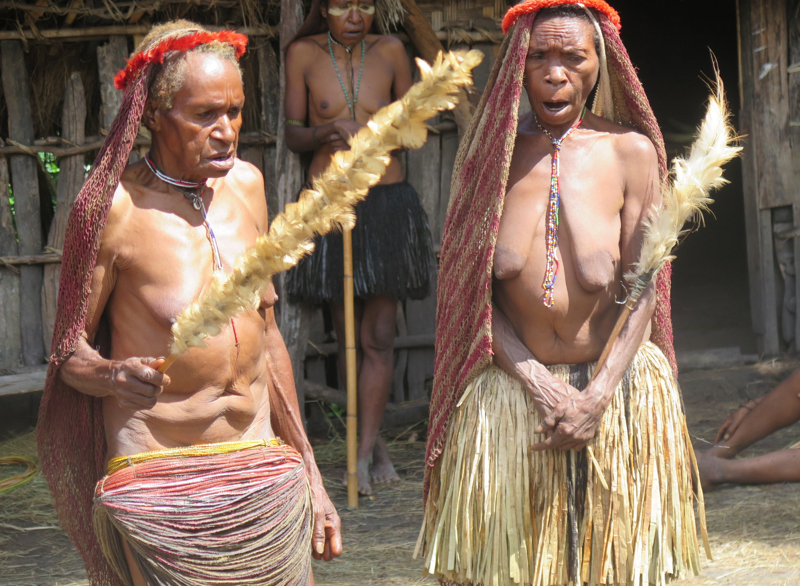
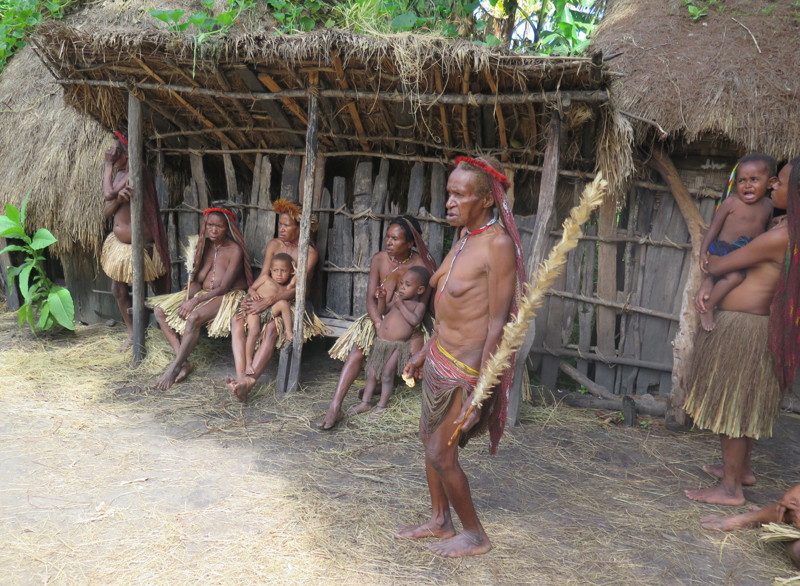
takes me by the hand and places a headdress on my head. It's funny to recall the beach in Java populated by Indonesian women wearing head scarves and how rude and inappropriate it felt to don our bikinis for swimming in a Muslim area, yet here we are feeling awkward dressed in our jumpers, as if we should be joining them and embracing their nakedness.
Everyone disperses to stand in a circle and watch a village elder making fire with a two pronged wooden instrument. Within minutes he has caused smoke and sparks to appear on the ball of kindling, which he nurses and blows until it bursts into flames. As a finishing touch, he lights his cigar from the fire. Although it the performance is
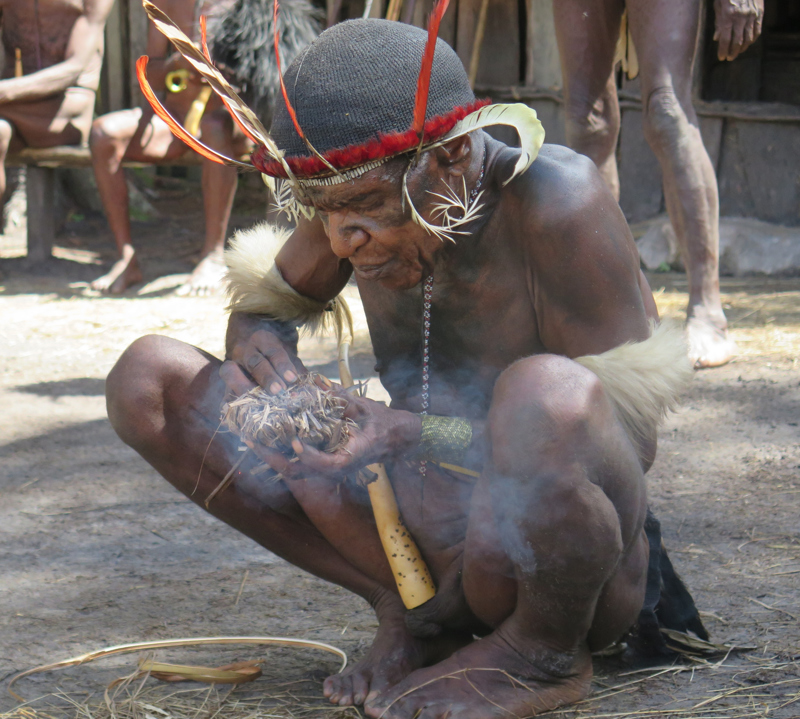
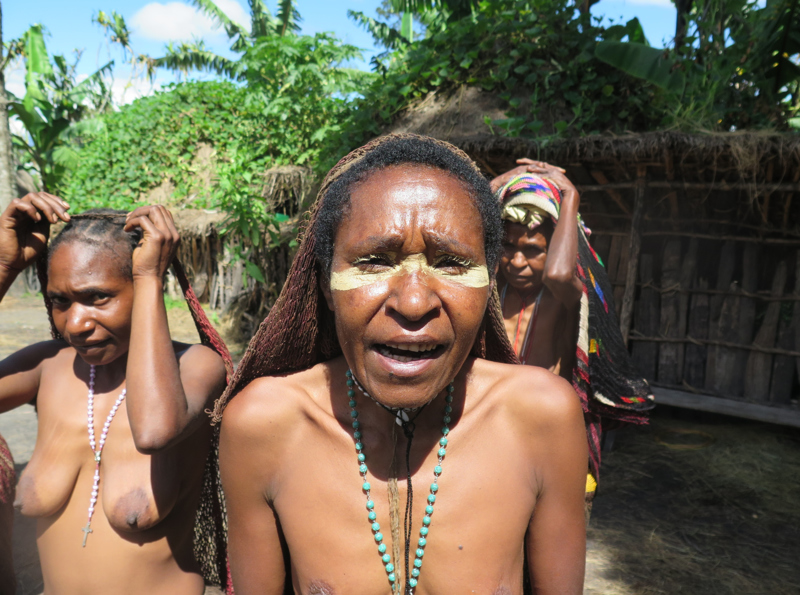
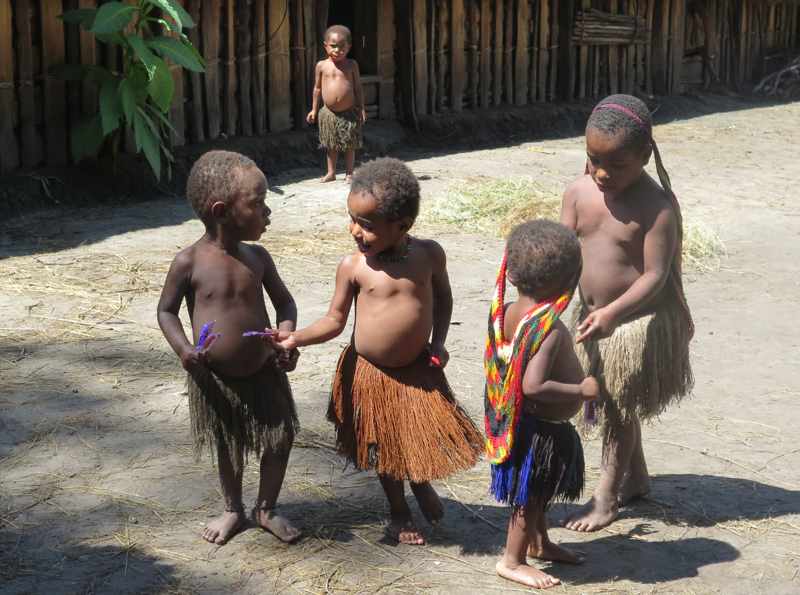
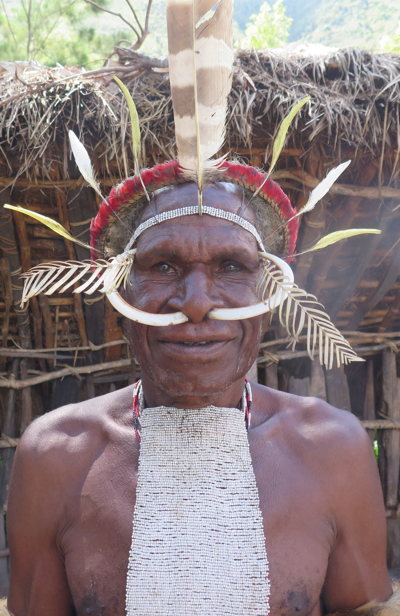
staged, it's been an incredibly enjoyable experience and interesting to see what their celebrations would have been like, assuming this may now be simply a tradition of the past. They lay out handmade souvenirs. Hannah buys a headdress and I choose one for my sister. They are made from feathers and animal skins, but where originally the thin, decorative plaits would have been made from leather dyed red or yellow, we notice, on close inspection, that they have used plastic chocolate wrappers in their stead. We quite like this modern creativity to recycle the materials they have access to - it gives the headdress an anachronistic touch. The rest of the tribe look upset and we feel guilty we have brought both from one lady but we have chosen the pieces we liked.
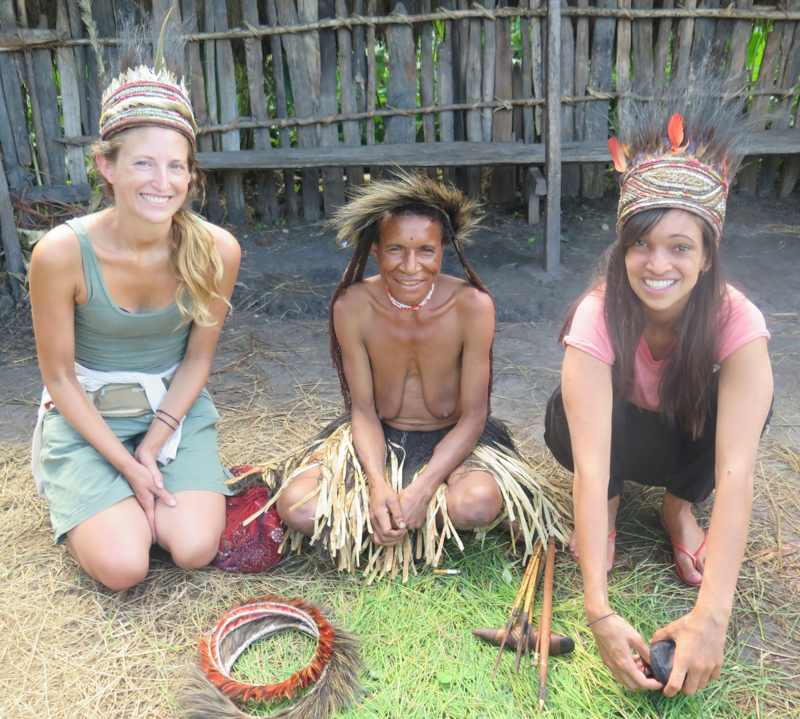
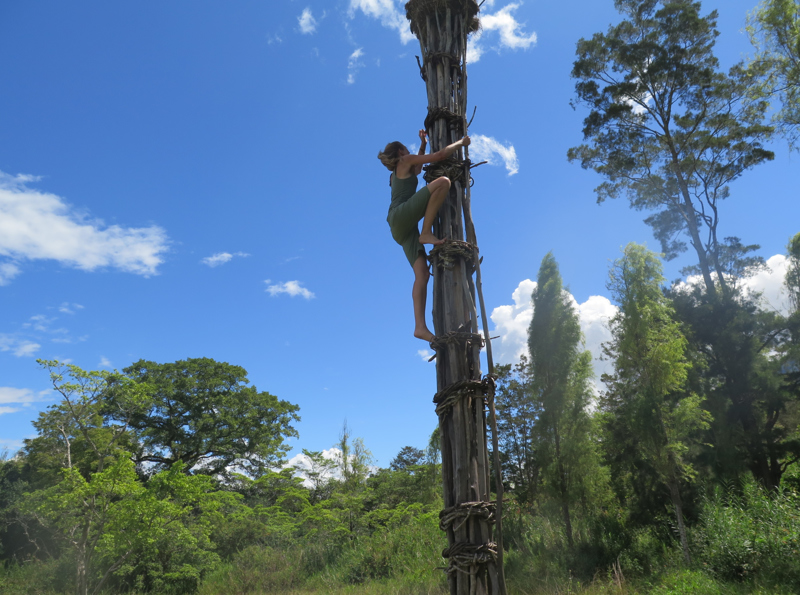
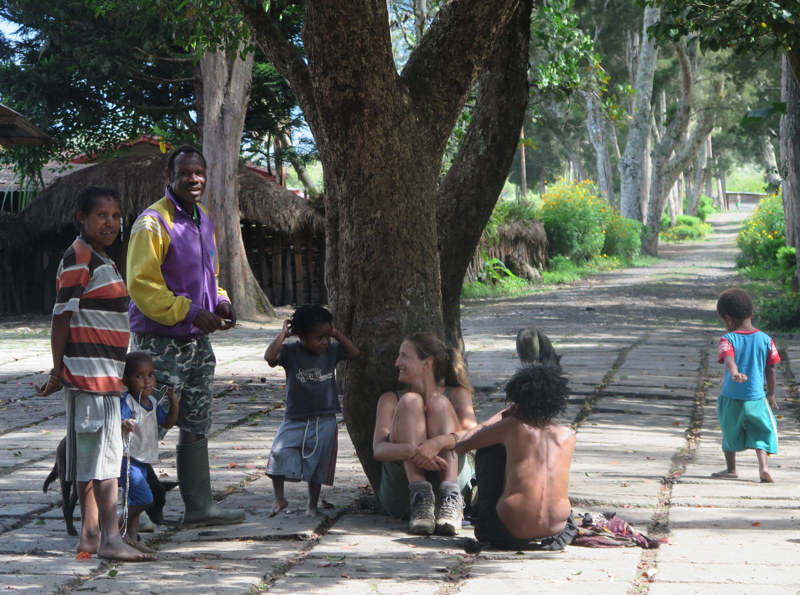
Before leaving the village, we climb the wobbly tower to view the surroundings, and then walk to visit Kurutu. The land in the valley is marshy, and manmade ponds have been created to lessen the risk of flooding. Our boots squelch in the mud underfoot. It costs 100,000 IDR to view the mummy in the village, so I sit leaning against a tree just outside while Hannah enters. A few people come and sit with me and we attempt to converse disjointedly with very few words. I hand out sweets and cigarettes. The guide has taken a few photos with my camera of the blackened skeleton, its legs folded to its chest.
The village is close to a road which transports us back to town. We sit on the grassy verge waiting for a public Bemo. A man wearing a penis gourd is busy farming in the fields. It's interesting that the older men still choose to wear no clothes and we like that this tradition lingers. Apparently the government had banned the penis gourd previously, but this law was later lifted. A group of people from the house opposite join us to chat - it's mainly a name-sharing session. One of the women is missing all the fingers on one hand, with only a thumb remaining. I hold her hand and look inquiringly at her. She mimes tears and crying, followed by a chopping motion and then uses a plastic wrapper to show how her finger was then wrapped up to stop the bleeding. After which, she laughs at her acting skills. I ask if this custom is still practised to which she shakes her head, although
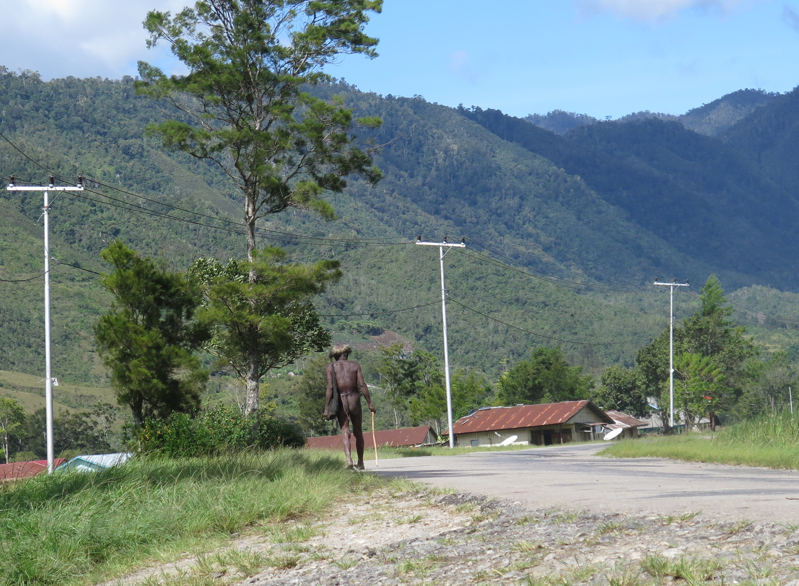
I'm not really sure if the question was understood, but I have only noticed the elder generation with missing fingers.
Back in town we give Wendy a tip, thank him for the trip and move to a different guesthouse with a shower, as we have not washed in 5 days! We have dinner at a hotel in town but are scared to walk home in the dark. The road to our guesthouse is quiet and void of street lights and as we are the only people staying in the house, we have managed to spook ourselves. One of the receptionists kindly carries us on the back of his scooter. The gate looks locked and the security guards in the courtyard have already gone home. The hotel employee, half laughing, helps us to open the gate, but the dog patrolling the area inside growls at us with his hackles raised. We loiter at the gate scared to pass through. The guy on the motorbike says 'it's ok' and leaves. We are aware of how pathetic we must look and determinedly walk through to our front door. The dog is unsurprisingly disinterested.
Day 51 - 18 Jun 14 fly to sentani
Edison meets us in the morning at the airport, where he queues up to get our boarding passes. One ticket is printed with a male customer’s name; the other is blank with the exception of a couple of handwritten figures. We are dubious as to whether they are valid, but we hand over the money regardless – no other option being available to us. The plane is due to leave at 7.30, but he tells us it's more likely to be at 9 or 10, so we sit in a cafe outside the building for breakfast. They have homemade banana cake, which is moist and delicious, so we buy a few pieces. A young guy practices his English on Hannah. Wendy is at the airport, hopefully waiting new tourists to arrive. We buy him breakfast too and in return, he rings a few hostels in Sentani for us and ensures we get on the right plane.
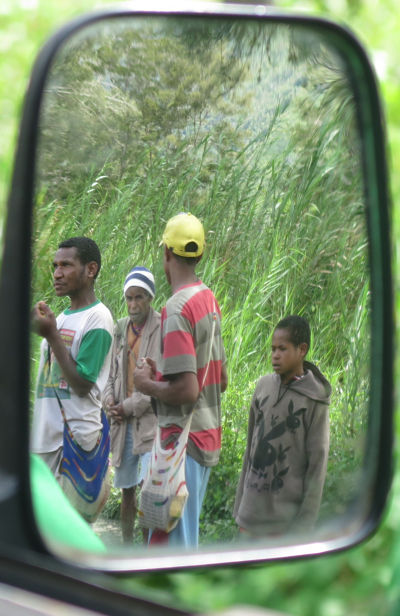
1.
Arrival in Jakarta, Pangandaran, Jogjakarta, Malang
2.
Volcanoes - Mt Semeru, Mt Bromo, Mt Ijen
3.
Ubud - a brief Sojourn
4.
Gilli Trawangan - white beaches and turquoise waters
5.
Boat Cruise - past the Komodo Dragons
6.
Flores - traditional villages and Mt Kelimutu
7.
Kuta, Lombok
8.
Baliem Valley - trekking in the mountains and meeting the Dani tribes
9.
Sentani - the festival and the lake
10.
Tana Toraja - Funerals and Burial Sites
11.
Kuala Lumpur - back in civilisation
12.
Cameron Highlands - trekking and tea plantations
13.
Georgetown, Penang - street art and crumbling mansions
14.
Banda Aceh and Pulau Weh - contending with Ramadan; Scuba Diving and snorkelling in paradise
15.
Lake Toba - the Batak people
16.
Bukit Lawang - Orangutans
17.
Unawatuna
18.
Volunteer Sri Lanka - Week 1
19.
Volunteer Sri Lanka Week 2
20.
Kandy and the East Coast
21.
Ella and Colombo
22.
Volunteer Sri Lanka - final week
23.
Earthbound Expedition - Kathmandu, Poon Hill and Chitwan National Park
24.
Back in Kathmandu
25.
Langtang - solo trekking
26.
Kathmandu to Varanasi
Share your travel adventures like this!
Create your own travel blog in one step
Share with friends and family to follow your journey
Easy set up, no technical knowledge needed and unlimited storage!